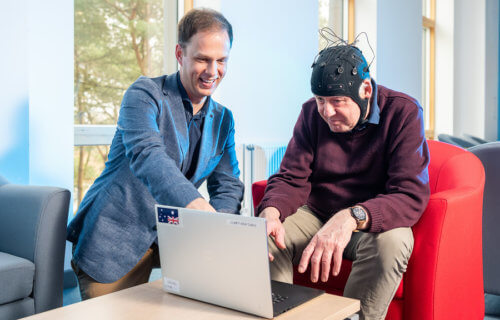BATH, United Kingdom — A two-minute test may revolutionize how doctors detect the signs of Alzheimer’s disease, leading to diagnoses years earlier than what is currently possible. A team from the University of Bath say the “Fastball EEG” may help lower the typical age for an Alzheimer’s diagnosis by up to five years.
The team says their new method passively (and quickly) scans the brain, meaning participants don’t have to understand what the test is doing or even respond to what’s going on during the exam. Participants using the Fastball EEG look at a series of flashing images on a computer screen for two minutes as the EEG cap measures their brain waves. The study finds this technique can effectively pick up small and subtle changes in the brain when a person is remembering an image they see.
“Fastball offers a genuinely novel way of measuring how our brain is functioning. The person being assessed doesn’t need to understand the test, or even respond, they simply watch a screen of flashing images and by the way we manipulate the images that appear we can learn an enormous amount about what their brain is, or is not, able to do,” says lead researcher and cognitive neuroscientist Dr. George Stothart from Bath’s Department of Psychology in a university release.
Taking years off of Alzheimer’s screenings
Researchers say the Fastball EEG is both cheap and portable, making it easily accessible for patients. The system also relies on pre-existing technology that is already in use in hospitals. The Fastball EEG is now being tested in a study of the early stages of Alzheimer’s — the most common form of dementia. In the United States, the CDC estimates that over six million people are living with Alzheimer’s disease in 2021.
Currently, doctors diagnose the neurological condition using the combination of subjective and objective which measure cognitive decline. These often include memory tests and other tasks which gauge mental ability. Unfortunately, researchers say these tests are also prone to many biases — like a person’s verbal and written communication abilities and even their level of anxiety — making them less reliable for some patients.
The Fastball EEG however, avoids these obstacles and study authors hope it will lower the average age of Alzheimer’s detection by at least five years. At the moment, doctors usually detect the signs of dementia in older patients who may have already been dealing with the disease quietly for years.
“The tests we currently use to diagnose Alzheimer’s miss the first 20 years of the disease, which means we are missing huge opportunities to help people. For decades now we have had tools in scientific research that have been able to probe how the brain is working, but we have never made the leap to a viable clinical tool for the objective assessment of cognition. We hope that Fastball may be that leap,” Dr. Stothart says.
More hope for Alzheimer’s patients on the way?
Study authors also note that the recently approved drug Aducanumab is the first disease-modifying treatment for Alzheimer’s disease. By knowing that someone has the disease much earlier in life, treatments like this may help doctors slow the progression of Alzheimer’s as their patients age.
“We are at a really exciting stage in its development. We are testing the tool in earlier and earlier stages of Alzheimer’s and expanding the type of brain function it can measure, to include language and visual processing. This will help us to not only understand Alzheimer’s but also the many other less common forms of dementia,” Dr. Stothart concludes.
“Ultimately the Holy Grail of a tool like this would be a dementia screening tool used in middle age for everyone, regardless of symptoms, in the same way we test for high blood pressure. We are a long way from that, but this is a step towards that goal.”
The study appears in the journal BRAIN.
